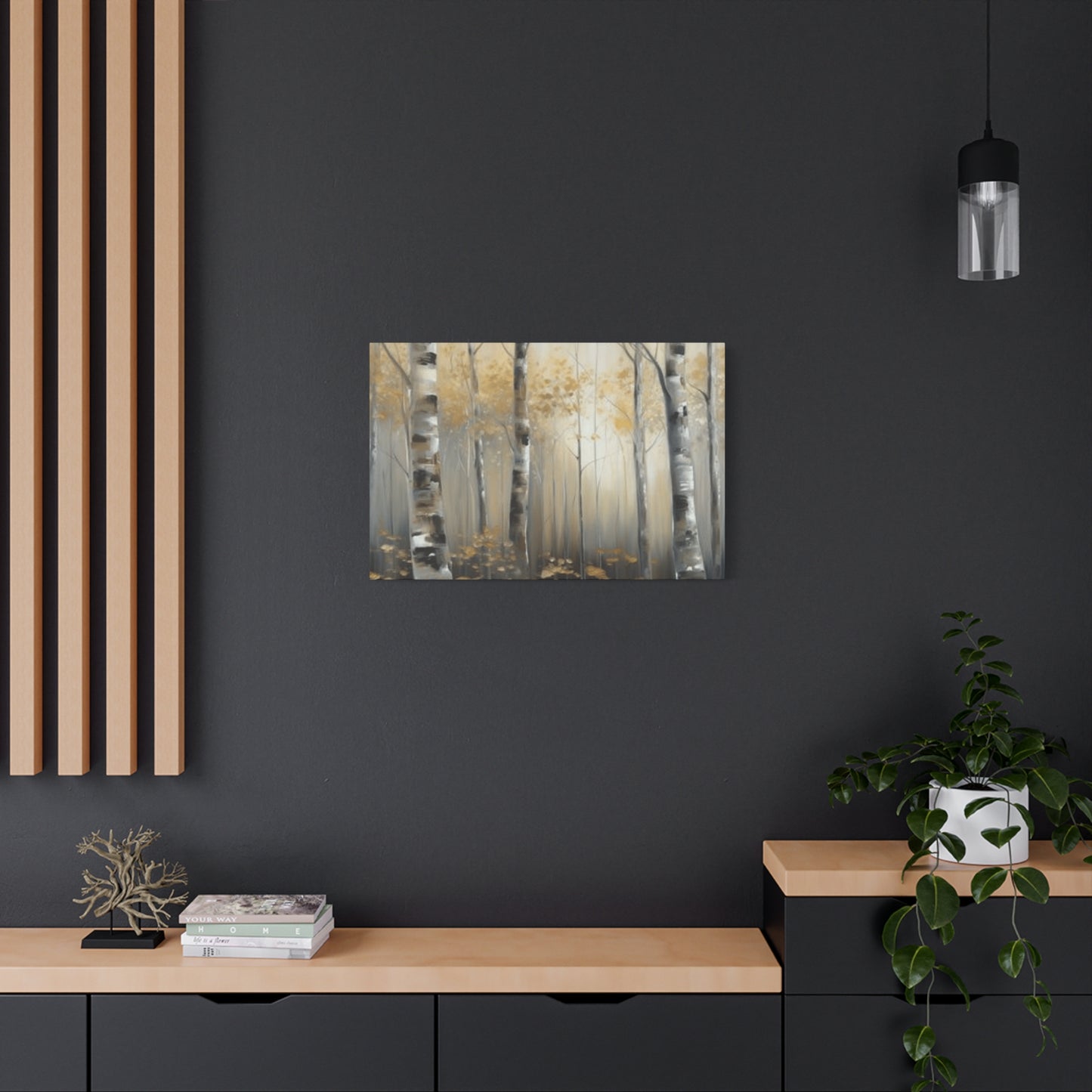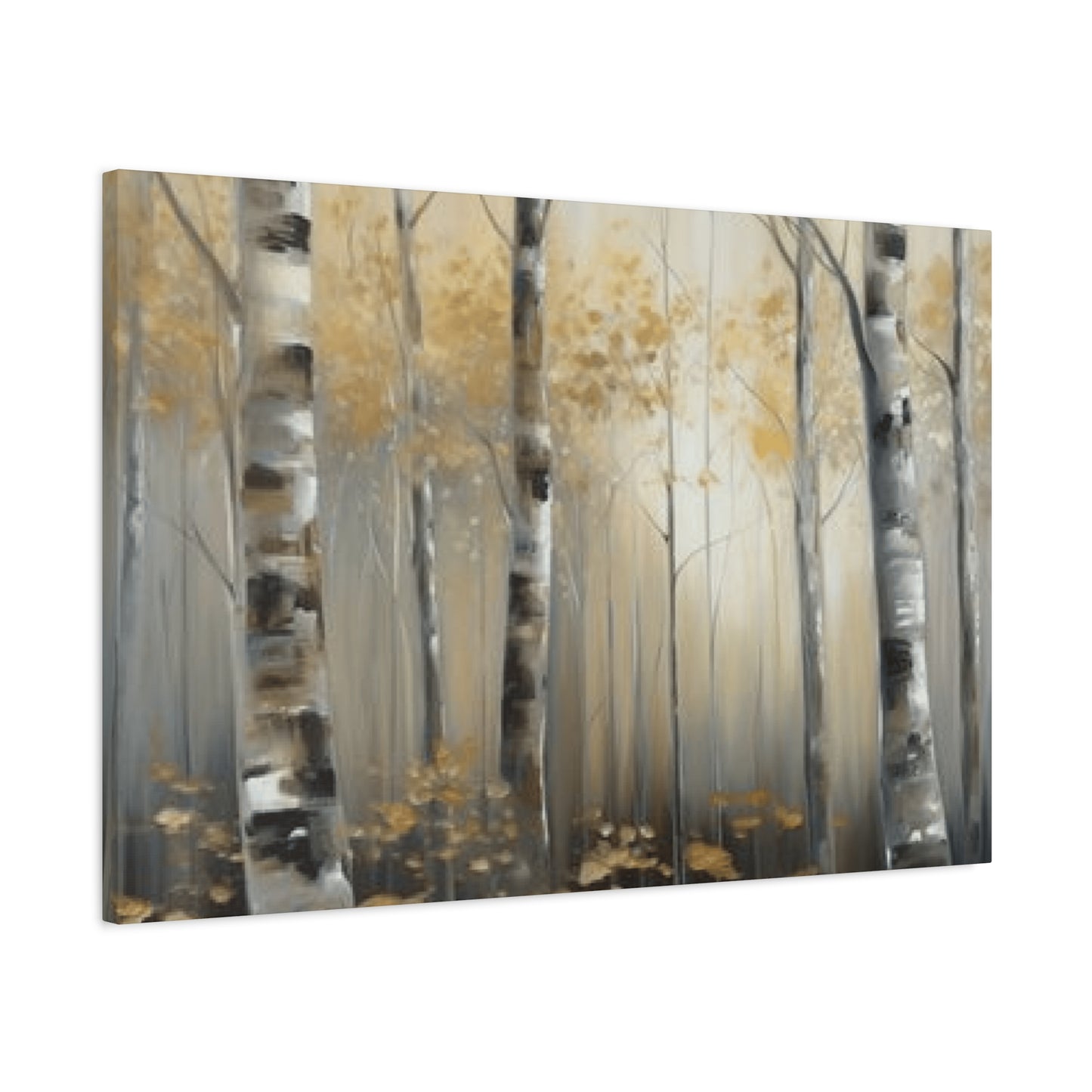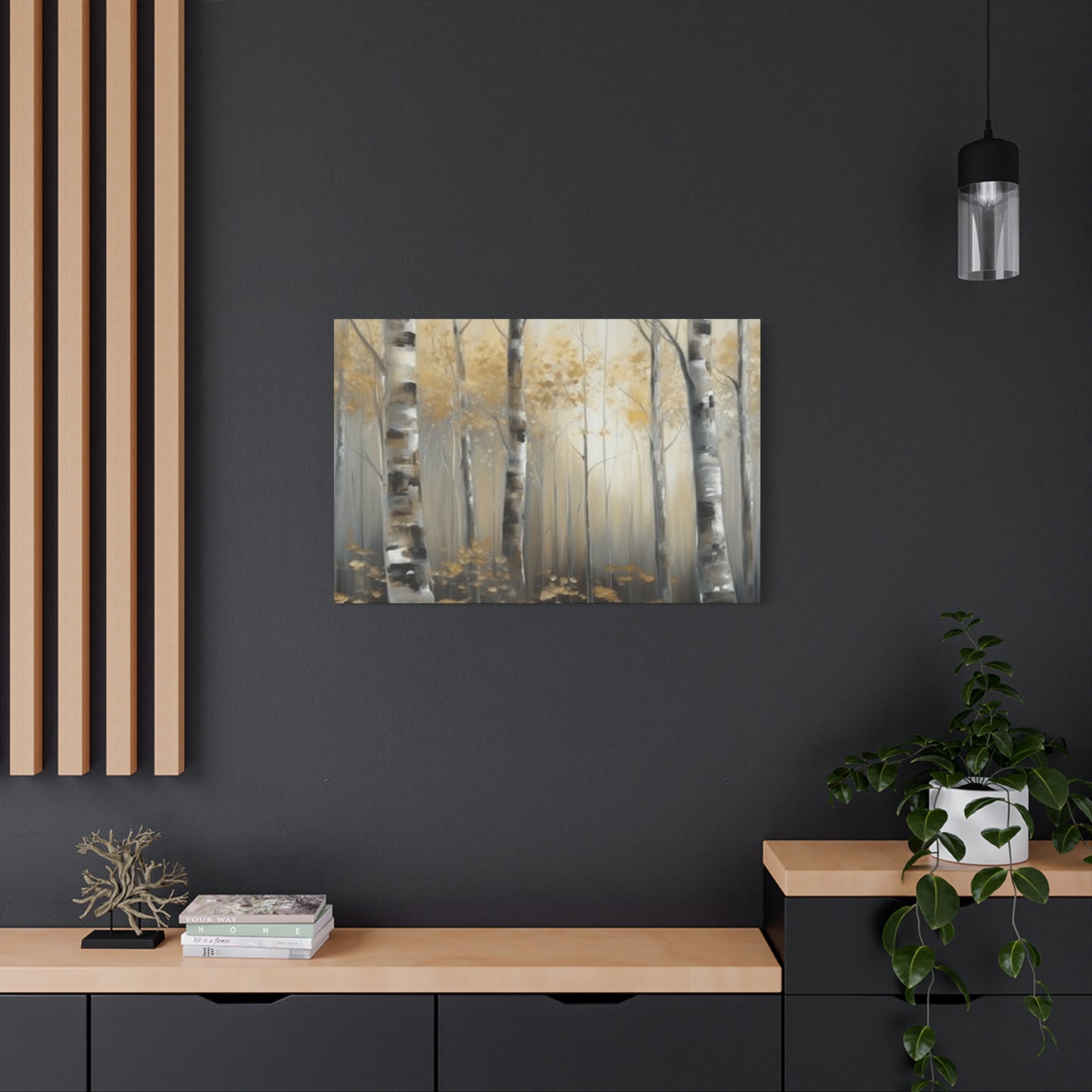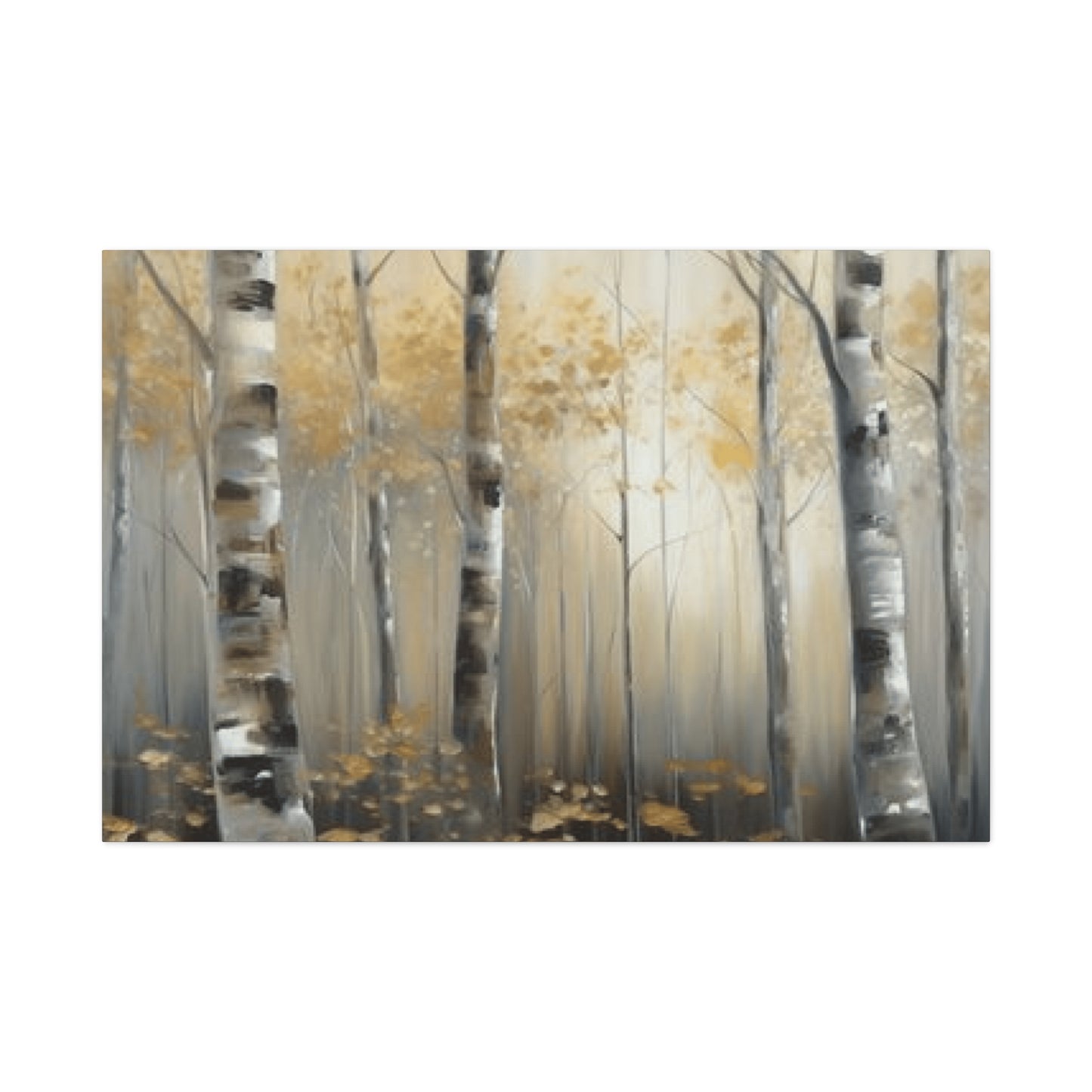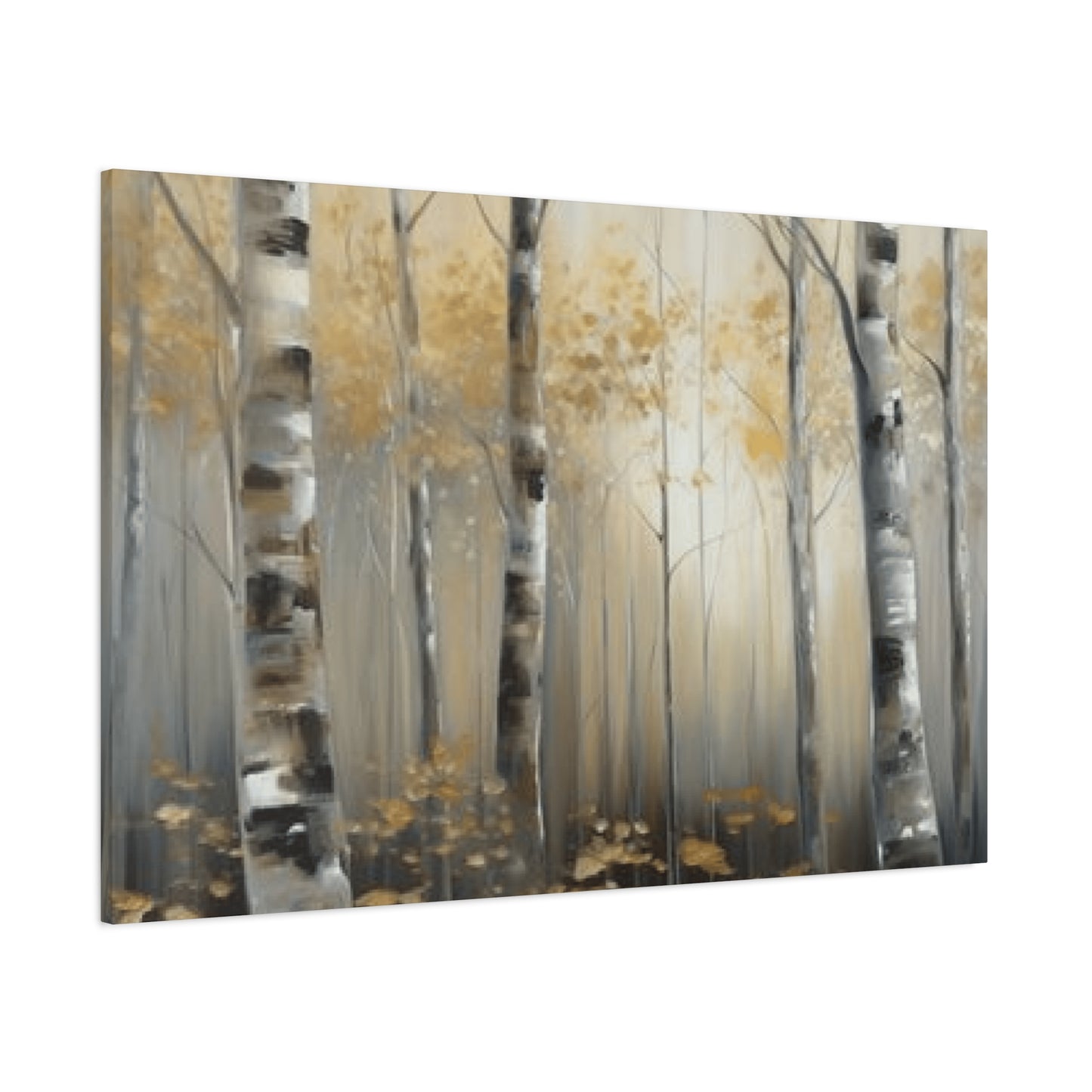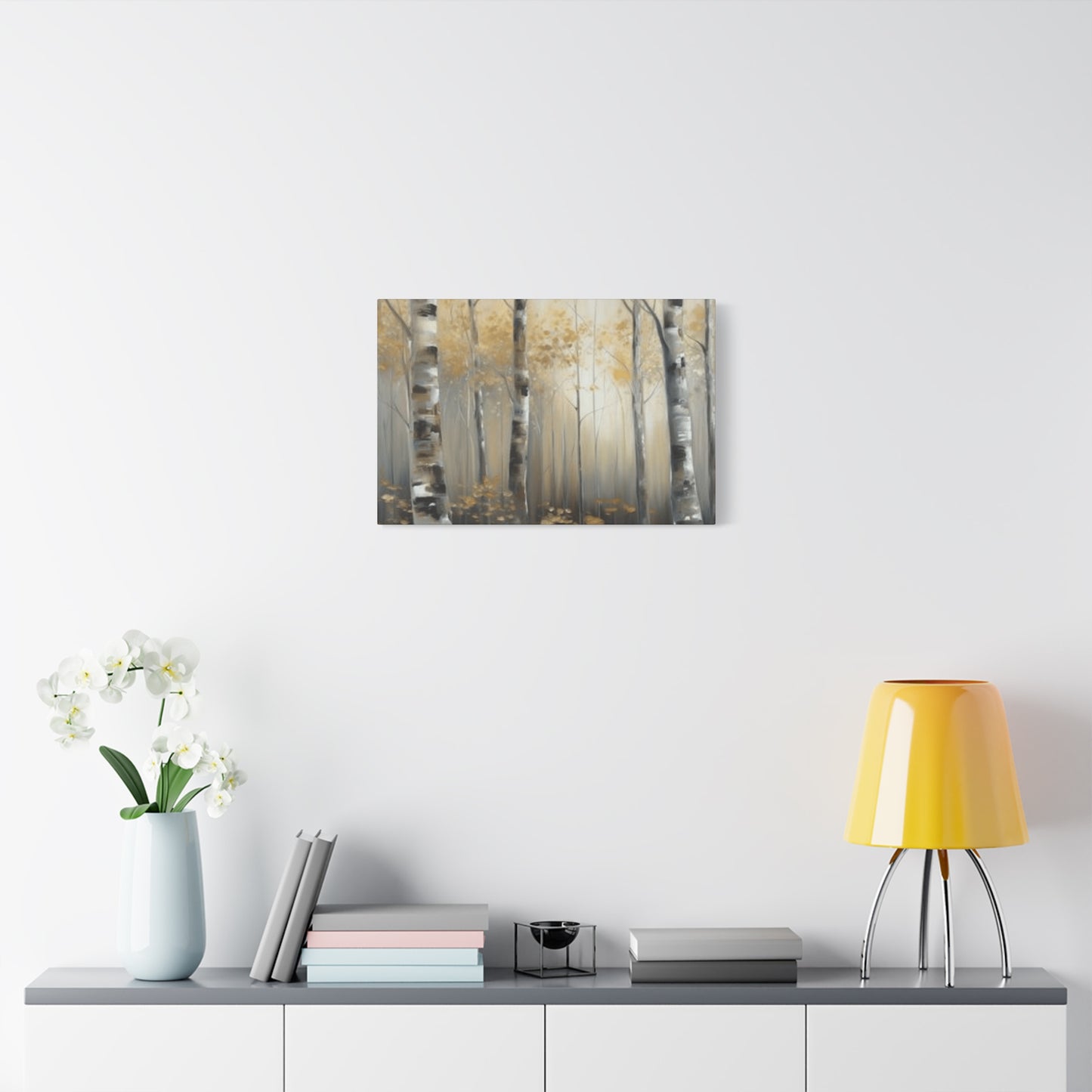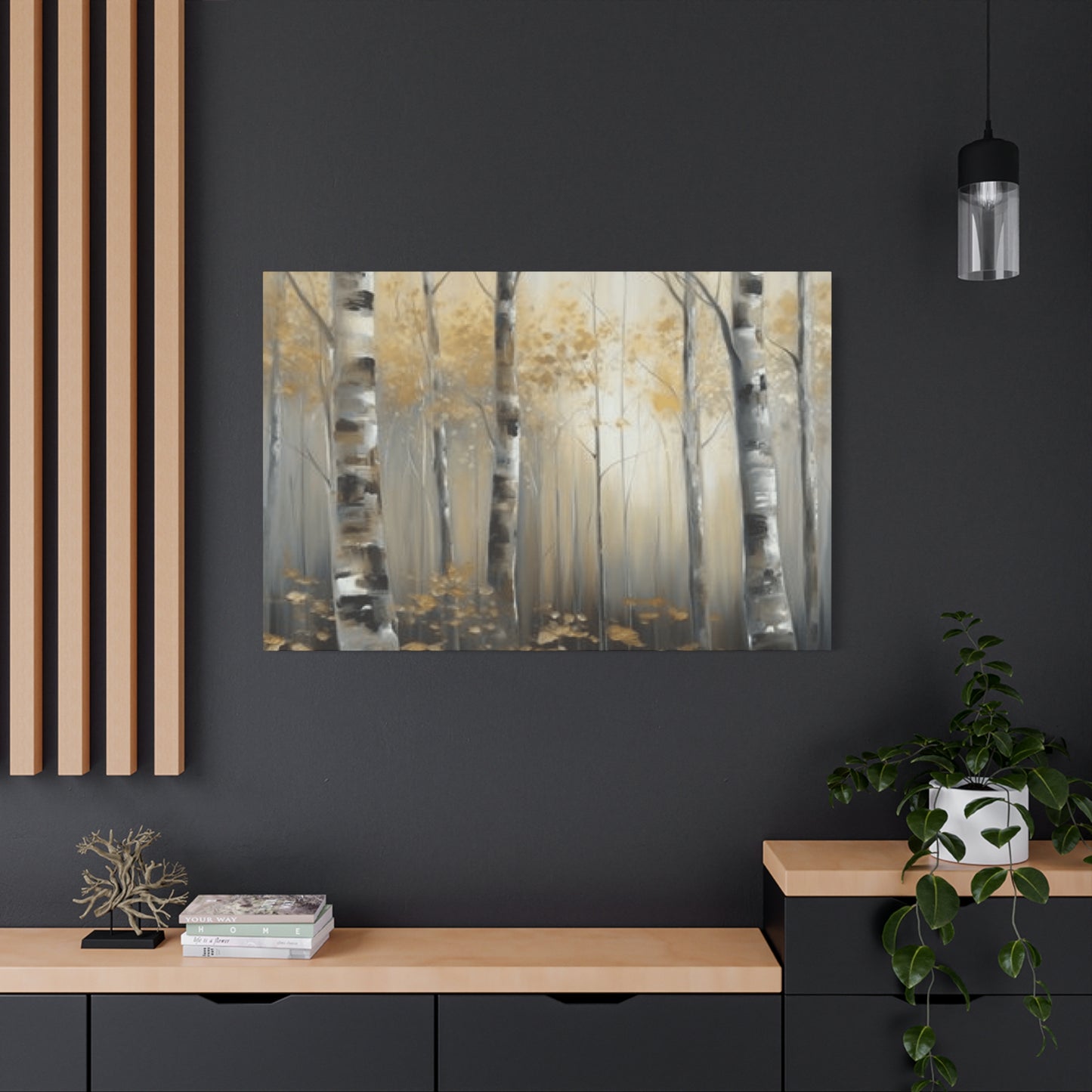Exploring the Enchanting World of Birch Tree Art: A Deep Dive into Nature-Inspired Canvas Creations
The allure of nature-themed artwork has captivated interior designers and homeowners for generations, with birch tree imagery standing out as a particularly versatile and sophisticated choice for contemporary living spaces. These striking white-barked trees, rendered in subtle earth tones and shadowy hues, offer a unique aesthetic that bridges the gap between natural beauty and refined artistic expression. Whether you're seeking to create a peaceful sanctuary in your bedroom, add character to your living area, or introduce organic elements into a professional workspace, artwork featuring these majestic trees provides an elegant solution that transcends fleeting design trends.
The distinctive appearance of these slender woodland specimens, with their characteristic papery bark and delicate branching patterns, translates beautifully to canvas. Artists have long been drawn to capturing the essence of these forests, particularly during the transitional moments of dawn and twilight when soft lighting creates an atmosphere of mystery and contemplation. This artistic tradition continues to evolve, offering modern interpretations that range from photorealistic renderings to abstract representations, each bringing its own unique perspective to wall décor.
The Serene Appeal of Evening Birch Tree Artwork
Creating peaceful environments through carefully selected artwork has become an essential aspect of modern interior design. When considering pieces that evoke tranquility, few subjects compare to the gentle presence of birch trees captured during the quiet hours of evening. These compositions typically feature a harmonious blend of muted colors, creating visual experiences that promote relaxation and mental clarity.
The magic of these artistic pieces lies in their ability to transport viewers to serene woodland settings without overwhelming the senses. Unlike bold, vibrant artwork that demands immediate attention, these subtle representations work quietly within a space, gradually revealing their depth and complexity. The interplay of shadow and light, characteristic of twilight scenes, creates a dynamic quality that changes throughout the day as natural light shifts across the canvas surface.
Artists working with these themes often employ a sophisticated color palette that includes various shades of gray, soft purples, gentle blues, and warm neutrals. This restrained approach to color selection ensures that the artwork remains versatile enough to complement a wide range of interior design schemes while maintaining its distinctive character. The vertical lines of the tree trunks create a sense of upward movement and height, making these pieces particularly effective in rooms with lower ceilings or where a sense of spaciousness is desired.
The textural quality of these paintings adds another dimension to their appeal. Many artists incorporate techniques that mimic the papery, peeling quality of birch bark, creating tactile interest that draws viewers closer for detailed examination. This attention to surface detail transforms a simple landscape into a multi-sensory experience that engages both visual and tactile imagination.
Gentle Color Schemes: Nature's Palette on Canvas
The subdued chromatic approach characteristic of twilight birch tree artwork represents a sophisticated understanding of color theory and its psychological effects on viewers. These carefully orchestrated color schemes draw inspiration from the natural world during its most contemplative moments, capturing the subtle transitions that occur when daylight fades and shadows deepen.
Professional artists specializing in this genre understand that restraint in color selection creates powerful emotional responses. Rather than relying on dramatic contrasts or saturated hues, they work with nuanced variations within a limited palette. This approach mirrors the actual visual experience of observing a forest at dusk, when colors become muted and forms soften into silhouettes.
The foundation of these color schemes typically begins with neutral bases ranging from warm grays to cool taupes. These foundational tones provide stability and allow the more distinctive elements of the composition to emerge naturally. Layered over these bases, artists introduce subtle variations of mauve, dusty rose, sage green, and soft amber. These secondary colors appear delicately, often blended to the point where they seem to emanate from within the canvas rather than sitting on its surface.
One particularly effective technique involves creating atmospheric depth through gradual color transitions. The background of these compositions often features lighter, cooler tones that suggest distance and space, while foreground elements incorporate slightly warmer or darker values to create a sense of proximity. This manipulation of color temperature and value creates convincing spatial relationships without requiring precise linear perspective.
The white bark of birch trees, rendered in these subtle contexts, takes on new characteristics. Rather than appearing as stark white, artists interpret this feature through a range of off-whites, creams, and pale grays, sometimes touched with hints of pink or blue reflected from the surrounding environment. This nuanced treatment of the trees' signature feature demonstrates the sophistication possible within a restrained color approach.
Capturing Enchantment: Woodland Scenes with Mysterious Depth
There exists something inherently captivating about forest imagery that suggests hidden depths and untold stories. Artwork depicting birch groves shrouded in evening shadows or morning mist taps into this universal fascination with woodland mysteries, creating pieces that invite contemplation and imagination.
These mysterious compositions work on multiple levels simultaneously. On the surface, they present viewers with recognizable natural scenes that provide visual pleasure and decorative value. However, the carefully constructed ambiguity within these works encourages deeper engagement. The spaces between trees become as important as the trees themselves, suggesting pathways leading to unknown destinations. This interplay between the visible and the obscured creates narrative tension that keeps the artwork engaging even after extended viewing.
Artists achieve this sense of mystery through various technical approaches. Atmospheric perspective plays a crucial role, with distant trees rendered in progressively lighter values and softer edges, creating the impression of depth and space. The strategic use of fog or mist effects further enhances this quality, obscuring details while allowing certain elements to emerge with greater clarity. This selective focus directs viewer attention while maintaining an overall sense of enigma.
Lighting choices prove equally important in establishing the mysterious quality of these works. Many artists prefer the transitional lighting conditions of dawn or dusk, when natural illumination creates long shadows and unusual color effects. During these liminal periods, familiar landscapes take on unfamiliar characteristics, becoming simultaneously recognizable and strange. This quality translates powerfully to canvas, creating artwork that feels both comforting and slightly otherworldly.
The vertical rhythm created by multiple tree trunks adds a formal structure to these otherwise atmospheric compositions. This repetition of linear elements creates pattern and movement, guiding the eye through the composition while suggesting the vastness of the forest beyond the frame. The slight variations in trunk spacing, thickness, and angle prevent monotony while maintaining cohesion.
Peaceful Presence: Bedroom-Appropriate Woodland Wall Decor
Selecting appropriate artwork for sleeping quarters requires particular consideration, as these spaces should promote rest and relaxation rather than stimulation or excitement. Nature-themed pieces featuring birch trees prove especially well-suited to bedroom environments, offering visual interest without the activating qualities of more dynamic subject matter.
The psychological effects of nature imagery in sleeping spaces have been documented through various studies, with consistent findings suggesting that exposure to natural scenes reduces stress and promotes feelings of calm. Birch tree artwork, with its inherent associations with quiet forests and pristine wilderness, taps directly into these beneficial effects. The vertical orientation of most birch compositions also proves advantageous in bedrooms, as it complements the vertical lines of doorways and windows while creating a sense of height that prevents the space from feeling confined.
Color selection becomes particularly crucial in bedroom applications. The muted, cool-leaning palettes typical of evening birch scenes align perfectly with the color psychology recommendations for sleep spaces. Blues, grays, and soft greens all fall within the range of colors known to promote relaxation and lower heart rate. By incorporating these tones within the context of a natural scene, the artwork provides these benefits while avoiding the clinical feeling that might result from solid blocks of color.
Placement considerations for bedroom artwork differ somewhat from those in more public areas of the home. Many designers recommend positioning substantial pieces on the wall opposite the bed, where they become the first sight upon waking. Alternatively, placing artwork above the headboard creates a focal point that grounds the sleeping area without overwhelming the space. The scale of the piece should be proportional to the wall and furniture, with larger canvases suited to spacious rooms and more modest pieces appropriate for cozier quarters.
The reflective quality of certain finishes on canvas prints deserves consideration in bedroom contexts. While glossy finishes can add richness to colors, they may also create unwanted reflections from windows or lighting fixtures. Matte or satin finishes typically prove more suitable for sleeping spaces, as they minimize reflections while still protecting the artwork and enhancing color depth.
Sophisticated Styling: Incorporating Forest Scenes into Contemporary Interiors
The intersection of natural imagery and modern design sensibilities creates exciting opportunities for interior decoration. Birch tree artwork, particularly pieces rendered in subtle evening tones, provides an ideal medium for achieving this balance. These works bring organic elements into streamlined contemporary spaces without introducing visual chaos or disrupting carefully curated aesthetic schemes.
Contemporary interior design often emphasizes clean lines, uncluttered surfaces, and restrained color palettes. Within these parameters, artwork serves as an opportunity to introduce personality and warmth. Nature-themed pieces featuring birch forests accomplish this goal while maintaining design coherence. The vertical lines of the trees echo the linear qualities common in modern furniture and architecture, creating visual harmony rather than conflict.
The neutral color schemes typical of contemporary spaces provide an ideal backdrop for artwork featuring subtle earth tones and shadowy hues. Rather than competing with bold wall colors or busy patterns, these pieces complement and enhance existing design elements. The organic forms of trees and branches soften the geometric precision of modern interiors, introducing natural curves and irregular shapes that prevent spaces from feeling too rigid or sterile.
Scale plays an important role in successfully incorporating these pieces into modern homes. Contemporary design often favors fewer, larger statement pieces over collections of smaller items. A substantial canvas featuring a birch forest can serve as a room's focal point, anchoring the space and providing a sense of purpose to the surrounding design elements. This approach also aligns with minimalist principles by reducing visual clutter while maximizing impact.
The frame selection for these pieces deserves careful attention in contemporary contexts. Simple frames in materials like natural wood, brushed metal, or even frameless presentations often prove most effective. Ornate or traditional frames can create dissonance with modern décor, while simpler options allow the artwork itself to shine while respecting the overall design aesthetic.
Warmth and Transition: Fall-Inspired Tree Canvases
The changing seasons provide endless inspiration for artists, with autumn offering particularly rich possibilities for birch tree compositions. Works that capture these trees during fall months bring warmth and depth to interior spaces through their incorporation of amber, rust, and golden tones layered over the characteristic white bark.
Seasonal artwork allows homeowners to introduce variety into their décor without requiring major redesign efforts. Fall-themed birch tree pieces work beautifully as rotating seasonal displays, though their sophisticated color palettes often prove appealing enough to warrant year-round presentation. The warm tones characteristic of these works create cozy atmospheres particularly appreciated during cooler months, though they can provide welcoming contrast during summer as well.
Artists working with autumnal birch themes have numerous approaches available. Some focus on the golden canopy created by changing leaves, using the white trunks as striking contrast against warm backgrounds. Others emphasize fallen leaves carpeting the forest floor, creating compositions rich in texture and color variation. Still others capture the transitional moment when some trees have shed their leaves while others retain their autumn glory, creating visual interest through this natural diversity.
The warm color palette of autumn scenes introduces different emotional qualities compared to cooler twilight interpretations. While evening scenes promote calm and contemplation, fall imagery evokes feelings of comfort, abundance, and gentle nostalgia. These emotional associations make autumn birch artwork particularly suitable for gathering spaces like living rooms and dining areas, where warmth and welcome are desired qualities.
Lighting considerations for warm-toned artwork differ from those for cooler pieces. Natural daylight enhances the golden qualities of autumn colors, making placement near windows potentially advantageous. However, careful consideration should be given to direct sunlight exposure, which can fade pigments over time. Artificial lighting in warm color temperatures complements these pieces beautifully, while cooler LED lighting may diminish their richness.
Atmospheric Conditions: Fog-Draped Forest Scenes
Few natural phenomena create more dramatic visual effects than fog moving through forest landscapes. Artists who capture birch trees emerging from or disappearing into misty conditions create works of remarkable atmospheric quality, pieces that seem to breathe with moisture and mystery.
The technical challenges of rendering fog or mist effectively require considerable artistic skill. Unlike solid objects, atmospheric effects lack defined edges and consistent opacity. Successful representation requires understanding how light behaves in moisture-laden air, how colors shift when viewed through fog, and how depth perception changes in reduced visibility conditions. Artists employ various techniques to achieve these effects, from careful blending of paint to create seamless transitions, to layering semi-transparent glazes that mimic the veiling quality of actual mist.
These fog-draped compositions create unique visual experiences. The softening effect of atmospheric moisture reduces contrast and blurs details, creating dreamlike qualities that transport viewers to quiet morning moments when the world seems suspended between sleep and wakefulness. The white bark of birch trees, already distinctive, becomes even more striking when set against misty backgrounds, appearing to glow softly as it emerges from obscurity.
The emotional resonance of these misty scenes differs from clearer forest depictions. Where crisp, detailed representations might feel grounded and concrete, fog-shrouded images embrace ambiguity and suggestion. This quality makes them particularly effective in spaces devoted to creative thinking or meditation, as their lack of precise definition allows the mind to wander and imagine.
From a design perspective, these atmospheric pieces offer remarkable versatility. Their naturally soft qualities prevent them from overwhelming smaller spaces, while their mysterious depth ensures they remain engaging even in larger installations. The reduced color saturation typical of foggy conditions also makes these pieces extremely adaptable to various décor schemes, as they rarely clash with existing color palettes.
Simplified Forms: Outline Studies of Woodland Trees
The power of simplification in art cannot be overstated. While detailed, realistic renderings certainly have their place, there exists equal beauty and impact in works that reduce subjects to essential forms. Artwork featuring birch trees rendered as simple silhouettes or minimal line studies demonstrates how much can be achieved with limited means.
These simplified approaches to birch tree imagery align perfectly with minimalist design principles that prioritize clarity, intentionality, and restraint. By stripping away detail and focusing on fundamental shapes and forms, artists create works that feel both contemporary and timeless. The distinctive profile of birch trees, with their slender trunks and delicate branching patterns, translates beautifully to this reductive approach.
Various artistic methods can achieve this simplified aesthetic. Some artists work with solid silhouettes, creating stark contrast between dark tree forms and lighter backgrounds. This high-contrast approach produces bold, graphic results that command attention despite their simplicity. Other artists prefer line drawings that capture the essential structure of trees through careful observation and selective mark-making. These linear approaches create delicate, airy compositions that bring natural elements into spaces without visual weight.
The versatility of these minimal interpretations makes them valuable in numerous design contexts. In contemporary spaces where visual restraint is paramount, these simplified pieces provide natural interest without disrupting design cohesion. In more traditional settings, they can serve as bridges between classic and modern elements, their subject matter familiar while their execution contemporary.
Color choices in simplified birch artwork often lean toward monochromatic or limited palettes. Black forms on white backgrounds create classic, sophisticated results, while reversed relationships produce more dramatic, unexpected effects. Some artists introduce single accent colors, perhaps suggesting autumn leaves or evening sky tones, adding subtle complexity to otherwise minimal compositions.
Woodland Tranquility: Forest-Themed Canvas Concepts
The concept of serenity in visual art involves more than simply depicting peaceful subjects. True serenity in artwork results from careful consideration of composition, color, balance, and emotional resonance. Forest scenes featuring birch trees, when executed with these principles in mind, create environments of profound calm within interior spaces.
Compositional choices significantly impact the serene quality of artwork. Asymmetrical balance, where visual weight is distributed unevenly but harmoniously across the canvas, often creates more interesting and restful compositions than rigid symmetry. In birch forest scenes, this might involve positioning a cluster of trees slightly off-center, balanced by negative space or atmospheric effects on the opposite side. This approach creates movement and interest while maintaining overall stability.
The rhythm created by repeated elements contributes substantially to feelings of serenity. The natural repetition of tree trunks, appearing at varied intervals and angles, establishes a visual rhythm that the eye follows comfortably through the composition. This rhythm should feel organic rather than mechanical, mirroring the irregular but harmonious patterns found in actual forests.
Negative space, the areas of the composition not occupied by obvious subject matter, plays an equally important role in creating serene artwork. These quiet areas give the eye places to rest and prevent compositions from feeling crowded or chaotic. In birch forest scenes, negative space might take the form of open sky, misty atmosphere, or shadowy depths between trees. Properly balanced, these areas enhance rather than diminish the impact of the primary subject.
The horizon line placement affects how grounded and stable a composition feels. Lower horizon lines create expansive sky areas that can feel uplifting and spacious, while higher horizons emphasize the forest floor and create more intimate, enclosed feelings. Neither approach is inherently superior; the choice depends on the specific emotional quality desired in the finished piece.
Contemporary Reinterpretations: Modernist Approaches to Forest Art
The tradition of landscape painting stretches back centuries, yet contemporary artists continue finding fresh perspectives on this classic subject. Abstract and modernist interpretations of birch forests demonstrate how timeless natural subjects can be reimagined through contemporary artistic lenses, creating works that honor tradition while speaking to current aesthetic sensibilities.
Abstract approaches to birch imagery might maintain recognizable elements like vertical lines suggesting trunks or organic shapes implying foliage while departing from realistic representation in color, proportion, or spatial relationships. These works occupy an interesting middle ground between pure abstraction and representational art, offering enough visual reference points to connect with nature themes while exercising considerable artistic freedom.
Color exploration in abstract birch work often ventures far beyond naturalistic palettes. Artists might render forests in unexpected color schemes, using vibrant jewel tones, metallic finishes, or monochromatic studies that transform familiar subjects into new visual experiences. These departures from expected color relationships challenge viewers to see common subjects with fresh eyes while creating unique décor options that add personality to contemporary spaces.
Textural experimentation represents another avenue for modernist interpretation. Some artists build up thick layers of paint, creating tactile surfaces that emphasize the physical nature of the artwork as an object rather than merely a window into represented space. Others might incorporate mixed media elements, adding papers, fabrics, or found materials that enhance meaning or create visual interest through material contrast.
Geometric interpretations of organic forms create fascinating tension between natural and constructed elements. By filtering the irregular, flowing forms of trees through geometric frameworks, artists create hybrid works that belong simultaneously to nature and human design. These pieces often resonate strongly in contemporary spaces where similar tensions between natural and manufactured elements exist throughout the décor.
Building Dimension: Multi-Layered Forest Compositions
Depth and dimension in two-dimensional artwork requires careful manipulation of various artistic elements. When depicting forest scenes, particularly those featuring multiple trees at varying distances, artists must employ sophisticated techniques to convince viewers' eyes that they're seeing into three-dimensional space rather than across a flat surface.
Atmospheric perspective, as previously mentioned, provides one crucial tool for creating depth. The principle that distant objects appear lighter, cooler in color, and less detailed than nearby objects allows artists to position elements convincingly in space. In multilayered birch forest compositions, this might manifest as sharply detailed foreground trees with visible bark texture, middle-ground trees with moderate detail, and background trees suggested through simplified forms and lighter values.
Overlapping creates another powerful depth cue. When one tree trunk passes in front of another, viewers immediately understand their relative positions in space. Strategic overlapping throughout a composition creates multiple depth planes, building rich spatial complexity that draws viewers into the scene. This technique works particularly well with birch forests, where the slender trunks create numerous opportunities for overlapping without creating visual confusion.
Scale variation reinforces spatial relationships established through other means. Trees positioned closer to the viewer should appear larger than those at greater distances, assuming similar actual sizes. Careful attention to these proportional relationships prevents compositions from feeling flat or spatially ambiguous. Some artists exaggerate these scale differences slightly for enhanced dramatic effect, creating more pronounced depth than might occur in natural vision.
Cast shadows provide additional depth information while adding visual interest. The shadows cast by foreground trees onto middle ground elements, or the patterns of light and shadow across the forest floor, create networks of spatial relationships that enhance three-dimensional illusion. These shadow patterns also introduce opportunities for value contrast and compositional design within the work.
Natural Retreats: Forest Imagery for Residential Interiors
The desire to bring elements of the natural world into living spaces runs deep in human psychology. In increasingly urbanized environments, artwork featuring forest scenes serves as a surrogate for direct nature contact, providing psychological benefits associated with natural environments within the home.
Living spaces benefit particularly from the calming influence of woodland imagery. These areas, where families gather and guests are entertained, should feel welcoming and comfortable without sacrificing style or visual interest. Birch forest artwork accomplishes this balance beautifully, offering sophistication and design value while maintaining approachable, universally appealing subject matter.
The versatility of forest-themed pieces allows them to function across various living space styles. In casual, family-oriented rooms, they provide visual interest without pretension. In more formal settings, they can be selected and presented in ways that emphasize their artistic and decorative qualities. This adaptability makes them wise investment pieces that can transition between spaces or design schemes as household needs and tastes evolve.
Size considerations for living space artwork often lean toward larger scales than might be chosen for bedrooms or offices. Living rooms, particularly those with high ceilings or extensive wall space, can accommodate substantial pieces that make bold statements. A large-scale birch forest composition might span several feet, creating an immersive visual experience that serves as the room's primary focal point.
Arrangement options extend beyond single large pieces. Some design schemes benefit from groupings of related works, perhaps featuring the same forest scene at different times of day or seasons, or various perspectives within a similar woodland setting. These collections create galleries that add visual complexity and demonstrate collecting sophistication while maintaining thematic coherence.
Subdued Sophistication: Muted-Palette Forest Canvas Works
The art of color restraint represents a high level of artistic sophistication. While vibrant, saturated colors have their place and purpose, subdued palettes demonstrate refined aesthetic sensibilities and create environments of subtle elegance. Birch forest artwork executed in muted tones exemplifies this sophisticated approach to color and design.
Creating effective artwork within limited color ranges requires deep understanding of value relationships, color temperature, and tonal variation. Artists working with muted palettes cannot rely on dramatic color contrasts to create interest and must instead develop nuanced handling of subtle shifts within restricted ranges. This often results in works of remarkable depth despite apparent simplicity.
The psychological effects of muted colors differ significantly from those of more saturated hues. While bright colors stimulate and energize, subdued tones calm and soothe. Spaces featuring artwork in restrained palettes tend to feel more peaceful and sophisticated than those with highly saturated color schemes. This makes muted forest scenes particularly appropriate for environments where calm and concentration are desired.
These subdued works also demonstrate remarkable longevity in design terms. While bold color choices can date quickly as trends shift, restrained palettes maintain relevance across changing fashions. This quality makes them sound investments for those seeking artwork that will remain aesthetically pleasing for years or decades rather than just seasons.
The interaction between muted artwork and interior lighting deserves consideration. These pieces often reveal additional complexity and subtle color variations under different lighting conditions. Morning light might emphasize cooler tones within the palette, while evening lamplight brings out warmer undertones. This changing quality keeps the artwork engaging and prevents it from becoming visual wallpaper even after extended daily exposure.
Northern European Design: Clean-Lined Tree Imagery
The design philosophies emerging from Nordic countries have gained worldwide recognition for their emphasis on simplicity, functionality, and connection to nature. Artwork featuring birch trees aligns perfectly with these principles, as these trees are native to Scandinavian regions and their clean, spare forms embody the aesthetic values central to this design tradition.
Scandinavian design prioritizes natural materials, pale color palettes, and uncluttered spaces that allow individual elements room to breathe. Within this context, artwork serves as carefully chosen accent rather than abundant decoration. A single well-executed piece featuring birch trees might be the only artwork in a room, given prominence through placement and presentation rather than quantity.
The characteristic white bark of birch trees resonates strongly with the preference for white and pale neutrals in Nordic interiors. This natural affinity means birch artwork integrates seamlessly into these color schemes while providing the connection to nature so valued in Scandinavian philosophy. The vertical lines of tree trunks complement the clean lines prevalent in Nordic furniture and architectural elements.
Minimalist execution suits these design contexts particularly well. Rather than detailed, busy compositions, Scandinavian-influenced spaces benefit from simplified interpretations that distill subject matter to essential elements. This might take the form of limited color palettes, reduced detail, or focus on silhouette and form rather than texture and complexity.
The cultural significance of birch trees in Nordic countries adds meaningful depth to their use in Scandinavian-inspired interiors. These trees represent resilience, purity, and the natural heritage of northern regions. Incorporating their imagery into living spaces creates connections to these symbolic meanings while maintaining the aesthetic priorities of Nordic design.
Bringing Outdoors Inside: Biophilic Design Through Forest Art
Biophilic design, the practice of incorporating natural elements and patterns into built environments, has gained significant traction as research confirms the psychological and physical benefits of nature connection. Artwork featuring forest scenes represents one accessible and impactful way to implement biophilic principles in residential and commercial spaces.
The human response to natural imagery appears to be deeply ingrained, likely reflecting our species' evolutionary history in natural rather than constructed environments. Studies consistently show that exposure to nature scenes, even through images, reduces stress markers, lowers blood pressure, and improves mood and cognitive function. By incorporating forest artwork into interior spaces, designers tap into these beneficial responses.
Birch forests offer particular advantages for biophilic design implementation. Their relatively light, open character prevents them from feeling too heavy or overwhelming in interior contexts, while their distinctive appearance ensures they register clearly as natural elements rather than generic decoration. The vertical orientation of trees also mirrors human posture and movement patterns, creating subconscious comfort and connection.
Effective biophilic design through artwork requires more than simply hanging any nature scene on available walls. The imagery should be high quality, engaging, and appropriately scaled for the space. Poor quality reproductions or inappropriately small pieces fail to create the immersive connection necessary for biophilic benefits. Investment in substantial, well-executed works yields significantly better results in terms of both aesthetic and psychological outcomes.
Placement strategies enhance biophilic impact. Positioning nature artwork in areas where people spend significant time, such as above seating areas or facing work surfaces, maximizes exposure and benefit. Creating visual connections between interior artwork and exterior views, when available, reinforces the indoor-outdoor relationship central to biophilic principles.
Professional Environments: Woodland Scenes in Workspaces
The selection of artwork for professional spaces involves different considerations than residential choices. Office environments require pieces that maintain professionalism while providing visual interest and supporting productive work atmospheres. Forest imagery, particularly sophisticated interpretations of birch groves, meets these requirements effectively.
Professional spaces benefit from artwork that avoids controversial or highly personal subject matter while still demonstrating design consideration and aesthetic awareness. Nature scenes, being universally accessible and generally well-received, provide safe yet sophisticated options. The specific choice of birch forests adds a layer of refinement through their distinctive appearance and design versatility.
The stress-reduction benefits of nature imagery prove particularly valuable in work environments. Office spaces, especially those lacking windows or natural views, can feel confined and oppressive. Artwork providing visual access to natural scenes offers psychological relief from this confinement, potentially improving employee wellbeing and productivity. Studies in workplace psychology support these benefits, showing measurable improvements in focus and reduced fatigue in offices incorporating nature elements.
Color selection for workplace artwork leans toward the cooler, more subdued palettes characteristic of evening forest scenes. These colors create calm, focused atmospheres conducive to concentration without the potentially soporific effects of very warm or overly muted schemes. The vertical lines of birch compositions also align well with the upward aspirations and structured environments of professional settings.
Scale and presentation in office contexts should project confidence and quality. Substantial pieces presented in professional frames demonstrate organizational investment in the work environment and respect for employees and visitors. Cheap prints in flimsy frames undermine the intended effect and may actually detract from the professional atmosphere rather than enhance it.
Artistic Methods: Rendering Trees in Gentle Illumination
The technical aspects of creating effective birch tree artwork deserve exploration, as understanding artistic process deepens appreciation for finished works. Capturing these subjects in soft, diffused lighting conditions presents specific challenges and opportunities that skilled artists navigate through various technical approaches.
Light behavior during dawn, dusk, or overcast conditions differs substantially from bright, direct sunlight. Indirect light reduces contrast, softens shadows, and creates subtle color transitions that require careful observation and skilled rendering. Artists working with these conditions must develop sensitivity to small value and color shifts that might be overlooked in more dramatic lighting.
Layering techniques prove particularly effective for creating the atmospheric quality of soft light. Many artists build up their compositions through multiple transparent or semi-transparent layers, allowing underlying colors and values to influence subsequent additions. This approach mimics the way light travels through atmosphere, being absorbed and scattered by particles and moisture. The resulting depth and luminosity cannot be achieved through single-layer application.
Blending skills become crucial when working with subtle transitions. Hard edges and abrupt value changes read as unnatural in soft lighting conditions, breaking the illusion of atmosphere and depth. Artists develop various blending methods, from careful brushwork to specialized tools, ensuring transitions appear seamless and natural. Digital artists employ similar principles through various software tools and techniques.
Color mixing for soft-light scenes requires particular attention to saturation levels and color temperature. Pure, highly saturated colors rarely appear in these conditions, as atmospheric effects naturally desaturate hues. Understanding how to mix appropriately muted versions of desired colors, while maintaining sufficient color presence to avoid muddiness, separates skilled artists from amateurs.
The treatment of the characteristic white birch bark in low-light conditions presents interesting challenges. Rather than pure white, these surfaces appear in various tinted grays, picking up color from surrounding atmosphere and light sources. Rendering them convincingly requires observation of these subtle color variations and the confidence to avoid overworking, which can deaden the luminous quality that makes these passages effective.
Creating Comfort: Tree Imagery for Intimate Spaces
Certain rooms in homes serve as personal retreats, places for reading, relaxation, or quiet contemplation. These intimate spaces benefit from artwork selection that supports their intended function, creating environments that feel safe, comfortable, and conducive to rest or introspection.
Scale considerations in smaller rooms differ from those in expansive spaces. While large pieces can create drama in generous rooms, they may overwhelm cozier areas. Moderately sized birch forest compositions often work best in intimate spaces, providing sufficient presence to register as intentional design elements without dominating limited visual real estate. The vertical orientation common to tree compositions proves advantageous in smaller rooms, drawing the eye upward and creating an impression of greater height.
The subject matter itself contributes to feelings of comfort and safety. Forests represent shelter and enclosure, creating psychological sensations of protection while maintaining openness through the spaces between trees. This balance between enclosure and openness produces feelings of security without claustrophobia, ideal for spaces meant for relaxation.
Personal connection to artwork matters more in private spaces than in public areas. While guests' reactions might influence artwork selection for living rooms or entryways, intimate spaces serve primarily the occupants themselves. This allows for more personal choices guided by individual emotional responses rather than design trends or others' likely reactions. If birch forest imagery resonates personally, that connection enhances its effectiveness in creating comfortable retreat spaces.
Lighting in intimate spaces often leans toward warmer and more subdued than in active areas. Artwork should be selected and positioned with these lighting conditions in mind. Pieces that appear too dark or lose their visual interest in limited light prove less effective than those maintaining presence across various illumination levels. Testing artwork in intended locations at different times of day ensures it will function well in actual use conditions.
Rustic Meets Modern: Bridging Design Styles with Forest Art
The intersection of rustic and contemporary design sensibilities creates rich opportunities for unique, personalized interiors. Birch forest artwork serves as an ideal bridge between these seemingly disparate styles, honoring natural, organic qualities while maintaining modern aesthetic sophistication.
Rustic design emphasizes natural materials, visible textures, and connections to traditional crafts and simpler lifestyles. Contemporary design prioritizes clean lines, edited decoration, and current stylistic expressions. On surface examination, these approaches appear contradictory, yet they share common ground in authenticity and quality. Both reject excessive ornamentation in favor of honest materials and straightforward presentation.
Artwork featuring birch trees embodies this shared ground. The subject matter directly references the natural world, satisfying rustic preferences for organic elements. However, the artistic execution, particularly in pieces with simplified forms or restrained palettes, aligns with contemporary aesthetic values. This dual nature allows birch forest art to function comfortably in spaces blending these design approaches.
Frame selection offers opportunities to adjust emphasis between rustic and contemporary qualities. Raw or lightly finished wood frames enhance rustic connections, while sleek metal or minimalist wood frames push pieces toward contemporary presentation. The same artwork can read quite differently based on these surrounding choices, offering flexibility in achieving desired overall effects.
The combination of rustic and contemporary elements, when executed thoughtfully, creates spaces with both warmth and sophistication. Birch forest artwork contributes to this goal by providing visual interest and personality without fussiness, grounding spaces in natural references while maintaining design clarity. This balancing act produces interiors that feel both timeless and current, comfortable yet polished.
Twilight Atmosphere: Capturing Trees at Day's End
The specific lighting conditions occurring as day transitions to night create uniquely beautiful opportunities for artistic exploration. Artists who specialize in capturing birch forests during these liminal moments produce works of particular atmospheric richness and emotional resonance.
The quality of light during twilight differs distinctly from any other time of day. As direct sunlight disappears, illumination becomes softer and more diffused, often taking on distinctive color qualities. The sky may display graduated tones from deep blue overhead through lavender and pink at the horizon. This complex, ever-changing light source creates extraordinary effects on landscape elements, particularly pale tree bark that seems to absorb and reflect the atmospheric colors.
Twilight scenes often incorporate the contrast between the still-visible landscape and emerging darkness. This interplay creates natural drama without requiring extreme contrasts or saturated colors. The gradual dimming of light suggests the passage of time and the cyclic nature of days, adding layers of meaning beyond simple visual appeal. These temporal qualities resonate emotionally, evoking memories of evening moments and associations with rest and closure.
Technical execution of twilight effects requires sophisticated color handling. The color palette must convey fading light while maintaining sufficient contrast and color interest to create engaging compositions. Artists navigate this challenge through careful value control and strategic placement of the strongest contrasts, ensuring the work remains visually coherent without becoming either too dark and obscure or too bright and lacking in twilight atmosphere.
The emotional content of twilight scenes tends toward contemplation and gentle melancholy rather than bright optimism or dramatic intensity. These subdued emotional qualities make them particularly appropriate for spaces meant to support reflection and calm. The quiet mood of evening imagery can help transition daily mental states from active engagement to relaxed receptivity, supporting healthy daily rhythms.
Conclusion:
Exploring the Enchanting World of Birch Tree Art: A Deep Dive into Nature-Inspired Canvas Creations illuminates the profound harmony between natural beauty and artistic interpretation. Birch trees, with their distinctive white bark, slender silhouettes, and whispering leaves, have long captivated artists and admirers alike. When translated onto canvas, they embody the essence of serenity, renewal, and timeless grace. This genre of wall art not only brings the outdoors inside but also redefines how nature can coexist with modern interior design—bridging the boundaries between realism, emotion, and aesthetic refinement.
At its core, birch tree art is a visual symphony of contrasts and balance. The pale, textured bark set against vibrant seasonal backdrops—spring greens, autumn golds, or winter whites—creates a rhythm that draws the eye and soothes the soul. These compositions speak to both stillness and vitality, encapsulating the cycles of life and nature’s quiet endurance. Whether painted in a minimalist monochrome palette or a rich impressionistic style, birch tree art resonates deeply with viewers by evoking familiarity, peace, and contemplation.
From a design perspective, birch tree canvas art offers unmatched versatility. Its natural color tones—soft whites, silvers, beiges, and muted blues—harmonize effortlessly with a wide range of interior aesthetics, from Scandinavian simplicity to rustic farmhouse warmth and even sleek modern minimalism. Large panoramic canvases create a sense of spaciousness and openness, particularly in smaller rooms where natural imagery visually expands the environment. Meanwhile, vertical birch compositions emphasize height and structure, ideal for creating visual flow in hallways or entryways. Every brushstroke becomes an invitation to breathe, relax, and reconnect with the calming presence of nature.
The emotional dimension of birch tree art cannot be understated. Birch trees symbolize resilience and rebirth—thriving even in challenging climates and regenerating after adversity. Their presence in art reminds viewers of nature’s persistence and the beauty found in simplicity. In home interiors, this emotional symbolism translates into comfort and renewal, making birch tree artwork an ideal choice for spaces designed for reflection, relaxation, or healing. Whether displayed in a bedroom, living room, or meditation space, the gentle allure of birch imagery nurtures a feeling of harmony and mindfulness.
Furthermore, birch tree canvases often function as visual meditations on texture and light. Artists play with layered brushwork, contrasting shadows, and subtle tonal shifts to capture the tactile quality of bark and the ethereal shimmer of light filtering through branches. This interplay of realism and abstraction allows each viewer to experience the artwork in a personal way—some see tranquility, others vitality, and many a sense of poetic nostalgia. The art becomes not just a depiction of trees, but a mirror reflecting human emotion and memory.
When integrated thoughtfully into home décor, birch tree wall art enhances spatial balance and emotional atmosphere. In bright, airy spaces, it amplifies natural light and openness; in darker rooms, it introduces a luminous focal point that softens the environment. The neutral tones complement textured materials such as linen, jute, and wood, reinforcing organic continuity throughout the design. Even in minimalist settings, a single birch tree canvas can become the defining element that infuses life and character into the space.
Ultimately, Birch Tree Art transcends visual beauty to become an emblem of peace, endurance, and natural grace. It reminds us that art inspired by nature holds a timeless power—the ability to reconnect people to what is essential, grounding, and eternal. The sight of slender trunks reaching upward, their bark glowing softly in painted light, evokes the same awe we feel when standing beneath an actual grove. Through this art form, walls transform into living landscapes, breathing life into interiors and nurturing the human spirit.
In essence, Exploring the Enchanting World of Birch Tree Art reveals how nature’s simplest elements can create the most profound artistic experiences. By capturing the delicate poetry of birch forests, these canvases merge tranquility and strength, light and shadow, simplicity and sophistication. They celebrate both the visual and emotional dimensions of the natural world, reminding us that beauty need not be grand to be transformative. Within every painted trunk and whispering leaf lies a message of hope, continuity, and quiet wonder—a message that, once brought into the home, turns every room into a sanctuary of elegance and serenity.

















